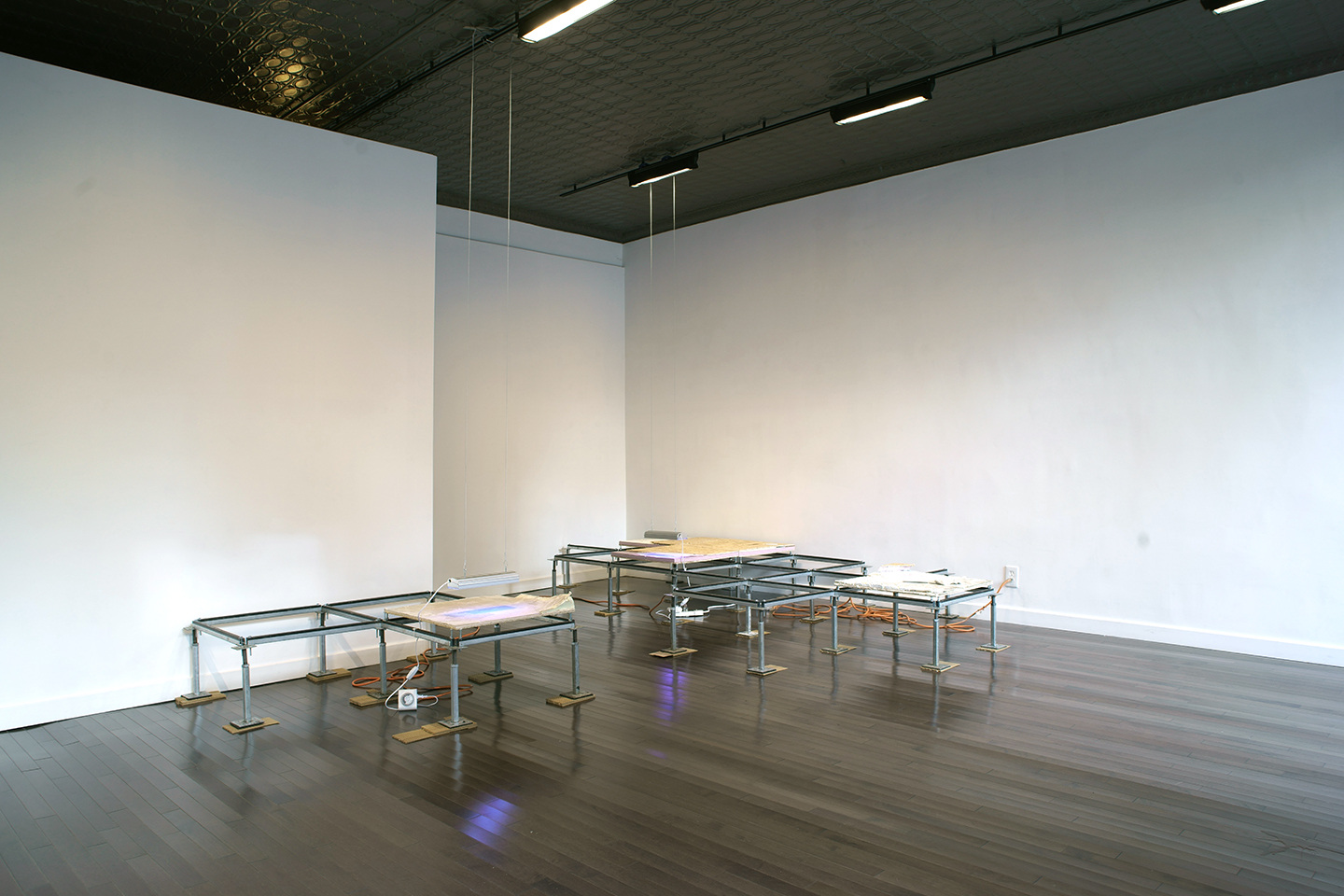
Arid Systems
2016
Marissa Lee Benedict
Salvaged raised access flooring pedestals and stringers, panels (pressboard, plastic, foam, concrete, fiber), UV lights, steel cable, composite plastic shims, extension cords; looping video on custom screen; glass suction cups and laminated inkjet print
Installation views at ︎︎︎The Ski Club, Milwaukee, WI, US.
___
Text below from ︎︎︎exhibition take away.
“Networked space is itself a medium, or whatever one might call a medium’s promiscuous, posthumous state today… But this space is also a sphere of liquidity, of looming rainstorms and unstable climates. It is the realm of complexity gone haywire, spinning strange feedback loops. A condition partly created by humans but also only partly controlled by them… We thought it was a plumbing system, so how did this tsunami creep up in my sink? How is this algorithm drying up this rice paddy?” – Hito Steyerl, “Too Much World: Is The Internet Dead?,” E-flux, Journal #49, Nov. 2013
Aridity, acceleration, evaporation, condensation, concentration. Aridity is the quality of “lacking interest and life,” of bareness, of fruitlessness, of low productivity, of sterility. Water underlies all forms of value. Keep hydrated, keep liquid, keep flowing, keep wet. Aridity is volatility. It is the enemy of smoothly functioning networks, of predictable bumper crops, of the unrestricted exchange of capital, of the free flow of information. Aridity, in its anxiety-inducing fluctuations, spurs the creation of redundant backup systems, wide buffers, and other attempts to avert crash and collapse. Aridity is accelerating agitation. It is the frictional breaking of molecular bonds as, energized by photons from the sun, liquids become gaseous – pulling apart, expanding and cracking the earth in a rapid exit towards the atmosphere. One of the primary effects of global warming – as described by atmospheric climate models and by newly observable weather patterns – is an increased volatility in water systems. Storms, such as Hurricane Patricia, swell in ferocity, appearing and dissipating at precipitate speeds. Sea levels rise and water evaporates out of places already considered deserts. Fog dissipates quickly in arid climates. Condensation occurs only at night. Aridity is the result of humidity drawn elsewhere – a condition understood not by what is materially present but by what becomes absent. Arid environments – extreme environments in general – erode boundaries, requiring life forms to either network and share valuable resources or to pour energy into strengthening barriers. Bubbles and bio-domes abound in volatile circumstances, and organisms at every scale are observed to behave in their own resource-specific self-interest. Spurred by the implicit need to retain “stability” within society and the environment, the dominant biologic form (the human) imagines methods of algorithmic maintenance and remediation. In practice, more often than not, people (and the extended network of organizations and institutions and industries and states in which they are entangled) create complicated snares and unexpected ruptures. But far more insidiously, it becomes clear that “stability” – rather than promoting social and ecologic equity – tends toward furthering a small portion of the species’ specific interests. And, perhaps even worse for future projections, we are well on our way to embedding and perpetuating these biases in our machinic systems. But what could happen if the backup system for the backup system fails? When the fragile data evaporates? What will the aluminosilicate bones and casings be good for? What shape are the pathways opened by escaping liquid? Could stranger, slier, more unexpectedly equitable forms of engagement occur in these fissures? Who will see the necessity for the break and the need for repair?